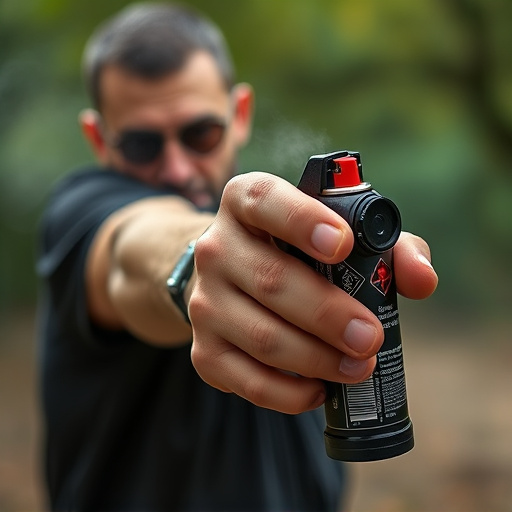Pepper spray is a potent self-defense tool effective within a 2-3 meter (6-10 feet) range, causing discomfort and disorientation to attackers. Optimal deployment distance requires considering personal safety, environmental conditions, and spray type, with no one-size-fits-all approach. Proper training, adjustable nozzles, and understanding wind conditions enhance its effectiveness. Best practices involve aiming low, using surprise factor, and adhering to legal guidelines for responsible use within this range.
“Uncover the power of maximum strength pepper spray—a potent self-defense tool designed to incapacitate and deter attackers. This comprehensive guide explores the intricacies of effective deployment distance, range, and accuracy, providing valuable insights for optimal protection. From understanding its powerful active ingredients to mastering application techniques and navigating legal considerations, we empower individuals to make informed decisions about using pepper spray responsibly for personal safety. Discover key strategies to maximize its impact and ensure you’re prepared in potentially dangerous situations.”
- Understanding Maximum Strength Pepper Spray: Power and Purpose
- How to Assess Effective Deployment Distance for Optimal Protection
- Key Factors Influencing Pepper Spray Range and Accuracy
- Best Practices for Maximizing the Impact of Your Defense
- Legal Considerations and Responsible Use of Pepper Spray
Understanding Maximum Strength Pepper Spray: Power and Purpose
Maximum strength pepper spray is a powerful self-defense tool designed to disable an attacker quickly and temporarily, providing users with a crucial window of opportunity to escape or seek help. Its effectiveness lies in its ability to irritate and inflame the eyes, respiratory system, and skin, causing severe discomfort and disorientation. This potent spray can stun assailants, allowing individuals to defend themselves from various threats, including close-quarters attacks and physical assaults.
The deployment distance range of maximum strength pepper spray is a key consideration for its practicality. With a typical effective range of 2-3 meters (6-10 feet), it offers users a safe distance to disable an attacker without requiring direct contact. This strategic advantage ensures that individuals can defend themselves from a distance, making it a reliable option in various self-defense scenarios, especially in high-risk situations or areas known for elevated crime rates.
How to Assess Effective Deployment Distance for Optimal Protection
Determining the optimal deployment distance for maximum effectiveness is crucial when it comes to pepper spray defense. The ideal range varies based on several factors, including personal safety needs, environmental conditions, and the specific type of pepper spray used. It’s important to understand that no one-size-fits-all answer exists; however, a general guideline is to aim for a distance that allows you to create a protective barrier while maintaining visibility and mobility.
To assess this effective pepper spray deployment distance range, consider practicing different scenarios in safe, controlled environments. Experiment with varying distances from potential threats, observing how the spray affects your vision, movement, and overall ability to defend yourself. Remember, the goal is to achieve enough distance for protection without sacrificing your ability to respond quickly.
Key Factors Influencing Pepper Spray Range and Accuracy
The effectiveness of pepper spray deployment distance and accuracy is influenced by several key factors. One of the primary considerations is the user’s technique; proper training ensures that the spray is directed precisely at the intended target, maximizing its impact while minimizing exposure to bystanders. Wind conditions also play a significant role, as crosswinds can significantly alter the spray’s path, making it more challenging to hit a specific mark. Additionally, the type of pepper spray used matters; different formulations and concentrations have varying range and potency levels.
The design of the spray device itself contributes to its range and accuracy. Modern pepper spray devices often incorporate advanced features like adjustable nozzle settings, allowing users to control the dispersion pattern for better targeting. Environmental factors, such as temperature and humidity, can also affect the spray’s performance, impacting its range and causing it to dissipate faster in humid conditions. Understanding these variables is crucial for law enforcement, security personnel, and individuals seeking effective self-defense options.
Best Practices for Maximizing the Impact of Your Defense
Maximizing the impact of your pepper spray defense involves understanding and adhering to best practices. Firstly, ensure you’re within the effective deployment distance range – typically around 2-3 metres (6-10 feet) – to guarantee maximum effectiveness. This proximity allows for direct contact with the attacker’s eyes, nose, and mouth, disrupting their balance and vision, which can enable a safe escape.
Additionally, proper technique is paramount. Aiming low, just above the waist, allows for better coverage of the attacker’s face while minimizing your exposure. Practice this movement to ensure swift and accurate deployment in high-stress situations. Remember, timing and surprise are key; deploy pepper spray unexpectedly to maximize its impact, disrupting the assailant’s momentum and providing crucial seconds for escape or assistance.
Legal Considerations and Responsible Use of Pepper Spray
When considering maximum strength pepper spray as a defense, it’s crucial to understand the legal implications and responsible use guidelines. The effectiveness of pepper spray deployment varies based on distance range, with studies indicating optimal performance within 2-3 meters. However, factors like wind, target movement, and individual sensitivity can impact its accuracy and potency beyond this range.
Legally, the use of pepper spray is regulated differently in various jurisdictions, with some areas permitting it only for law enforcement or self-defense purposes. Users must ensure they operate within the legal boundaries, respecting the rights and safety of others. Responsible use involves aiming carefully, allowing the spray to take effect, and ensuring minimal exposure to bystanders, as the irritant can cause temporary blindness, breathing difficulties, and other adverse reactions in unintended individuals.
In conclusion, understanding maximum strength pepper spray’s power and purpose, along with optimal deployment distance, key range and accuracy factors, best practices, and legal considerations, equips individuals to make informed decisions for self-defense. By employing effective pepper spray deployment techniques, users can maximize its impact while adhering to responsible use guidelines, ensuring both personal safety and compliance with the law.
